Dubai conference highlights how District Cooling is contributing to smarter urban growth
The role of District Cooling in enhancing energy efficiency towards achieving smarter cities was the central theme of District Cooling 2018, which ran from December 9 to 11, in Dubai. Organised and conducted by the International District Energy Association (IDEA) and hosted by Empower, the Dubai-headquartered District Cooling utility provider, the conference drew a cross section of utilities, consultants, contractors, building operators, suppliers and technology solutions providers from across the world.
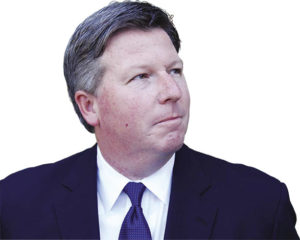
Rob Thornton, President and CEO, IDEA
The conference commenced with a panel discussion, titled ‘Efficient Energy for Smarter Cities’. Moderated by Rob Thornton, President and CEO, IDEA, it featured senior industry executives from the Middle East, North America and Europe. The panelists discussed what makes District Cooling key for smarter cities, potential areas of improvement with regard to customer engagement, the feasibility of thermal energy storage and efficient infrastructure models based on inter national references. The second panel discussion, titled ‘Operational Excellence – Global Best Practices and Strategies’ saw a panel of experts discuss how strategies for operation and maintenance must support good design, and the importance of anticipating the lifecycle to ensure quality service. The panel shared innovative practices, tools and techniques to ensure operational excellence, and discussed assessing the carbon footprint of systems. A subsequent panel discussion, titled ‘Financing the District Energy Enterprise’, featured panelists in the fields of banking, finance and District Energy and tackled the subject of how the growth of District Energy is largely dependent on the availability of both short- and long-term funds, and how its economic success relies on the sharing of risk, pricing and capital.
The conference also saw over 20 presentations from industry experts on a variety of topics, such as the vital roles that automation and machine learning play in enhancing operational efficiency, the best way to address common technical issues and concerns, and the growing demand of a skilled workforce in the field. The Danish Board of District Heating, in cooperation with Danish manufacturers, also held a breakout session on ‘Scandinavian Energy Efficiency Technologies and Best Practices in Advanced District Cooling’.
On the sidelines of the conference was the tradeshow, which featured exhibitors highlighting products and innovations relating to District Energy. The conference concluded with a panel, titled ‘Global Expertise, Innovation and Solutions’(See Voices, page 40). It featured a delegation from North America, which discussed challenges, opportunities and key issues relating to District Cooling, micro grids, system optimisation, the energy-water nexus and customer expectations. The session was presented in a town hall setting, in a bid to encourage audience members to pose their questions to the expert panelists, sparking a lively discussion from both camps.The conference concluded with a technical tour of Empower’s District Cooling scheme.
Panel Discussion 1: ‘Efficient energy for smarter cities’
Rob Thornton, President and CEO, International District Energy Association (IDEA), kicked off the first panel discussion by commending the uptake of District Cooling in Dubai in just a short period of time, underscoring the two million tonnes of refrigeration (TR) capacity it holds today. This became the take-off point for Thornton’s next set of questions, all with the aim of identifying what makes District Cooling key for smart cities. “Is it efficiency and plant performance because of load differentiation?” he asked. “Is it integrating thermal storage and avoiding expensive electricity? Is it smart meters, where we help customers use energy more effectively? Or, D, is it all of the above?”
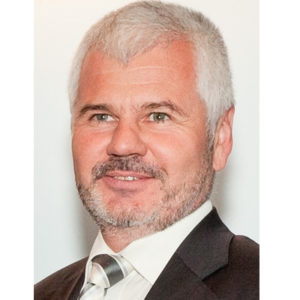
Werner Lutsch, Managing Director and CEO, AGFW
Werner Lutsch, Managing Director and CEO, AGFW, answered that it was D, all of the above, stressing that all aspects are essential in the move towards smart cities. Seconding this was, Adib Moubadder, Chief Executive Officer, Emirates District Cooling (Emicool), who stressed that “a smart city cannot be attained without sustainable development and long-term solutions related to infrastructure”. Smart meters, he added, are also vital for raising awareness among customers on the need to be more conscious of energy consumption. In agreement was Michael Schack, Director, Decentralized Solutions for Cities and Territories, ENGIE, who added that while District Cooling has a bright future, and that it is set to be a preferred solution in the coming years, educating customers is necessary, and championing a comprehensive approach is a key requirement.
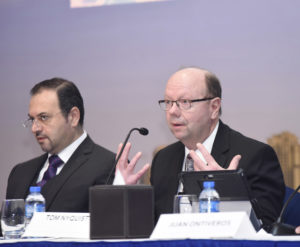
L-R: Adib Moubader and Tom Nyquist
Tom Nyquist, Executive Director, Engineering and Utilities, Princeton University, also weighed in on the value of implementing a comprehensive approach, sharing recent investments being made by Princeton in this regard, not only for HVAC projects within buildings but also in converting the entire campus from fluorescent to LED lamps, which helped reduce the lighting load on the campus by 10%. While a District Energy system offers flexibility with loads, Nyquist stressed that this is not the case with individual chillers, which is a lot harder to control with a central plant, and, if located in isolated buildings, can lead to stranded capacity. Providing an example, Nyquist pointed to an off-campus data centre, originally designed to accommodate a particular load, but since the operators decided later on to come up with virtual servers, the loads did not go up as anticipated.
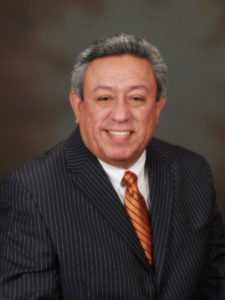
Juan Ontiveros, Asst VP, Utilities, Energy and Facilities Management, University of Texas at Austin
Also advocating a well-rounded approach was Juan Ontiveros, Assistant Vice President, Energy and Utilities, University of Texas at Austin, who outlined innovative approaches being implemented in the campus, which Thornton described as a “small city” in itself (See related interview on page 46). “We have been producing 100% of energy [we use] since 1929,” Ontiveros said, adding that the university’s philosophy is to get the best equipment within the budget and adapt accordingly, to ensure there are no losses in the system. The university, Ontiveros said, runs equipment, such as towers and pumps, in part-load conditions to maximise power savings. He added that the university also undertakes a careful assessment of chilled water conditions and sources. “We try to understand where the constraints are in the distribution system to minimise the amount of horsepower [needed] to pump water, then we do thermal energy storage,” he explained.
Currently boasting a capacity of 60,600 tonnes of refrigeration, the university, Ontiveros said, continuously adjusts its system every few seconds in order to gain further understanding on what is being done, adding that effective application of thermal storage allows the campus to optimise its chillers, extend the life of its equipment and achieve 30,000 TR of spare capacity. “You can’t just look at pumps, chillers or towers,” he said. “You have to look at it altogether and really try to consider the whole system holistically to use less fuel and less energy.”
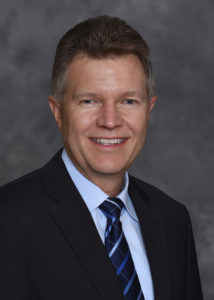
Jim Lodge, Vice President, Clearway Energy
Jim Lodge, Vice President, Clearway Energy, in Phoenix, Arizona, also spoke of his experience leading up to the current model of using ice storage as the utility’s core capacity in Arizona. In the beginning, Lodge said, he had to face a sceptical customer base, owing to their negative experience related to the use of thermal storage in commercial office buildings, which, he said, failed because of the operators’ lack of training and inadequate skill set. To overcome this bottleneck and convince stakeholders to get on board with Clearway Energy’s proposal of a District Cooling system, Lodge said the first step was to showcase successful reference projects across the United States to highlight the benefit of proper operations. This, he said, proved to be successful. “Our operators absolutely love thermal storage, because it’s like a battery back-up for them,” Lodge said. “Not only do we use for peak shaving, we shift about 10 megawatts from on-peak to off-peak electricity demand – it’s an emigrated strategy in Phoenix. It’s not just sitting there waiting to be used; it is actually replacing multiple chillers, and we count on it, just like we count on mechanical equipment.”
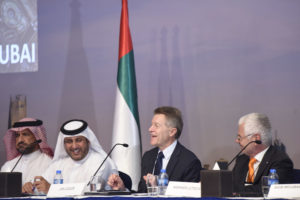
L-R- Abdusalem Al Mobayed, Ahmad Bin Shafar, Jim Lodge and Werner Lutsch
Providing a Middle Eastern perspective, Abdusalem Al Mobayed, CEO, Saudi Tabreed Operation and Maintenance Company, said that in addition to peak-load shaving, thermal storage provides redundancy to the Tabreed scheme. “In case of any power interruption,” he said, “we start our emergency DC generator, run a couple of secondary pumps and start supplying chilled water from the thermal storage to our end-users and clients, until the problem get fixed.” Al Mobayed added that regulations also have a vital role to play in helping enhance the value of thermal storage for its benefit to be revealed to the end users, touching on the feasibility of price signals. Ahmad Bin Shafar, CEO, Empower, said that in the United Arab Emirates, there is still one price tariff charge, making it difficult to quantify the actual savings District Cooling provides. He added that, while Dubai, undoubtedly, occupies a leadership role when it comes to District Cooling in the Middle East – for which he commended the solution providers in the fields of sub-metering, thermal storage and treated sewage effluent (TSE) – he believes the market is still premature and that “it will take 5-10 years to reach the second level”.
Thornton weighed in and said that similar challenges exist in the United States, where not every utility or independent system operator effectively delivers a grand price signal between the afternoon and evening, which impacts how District Energy systems perform in certain markets. “I think in Texas, during summer months, price has reached USD 9,600 a megawatt-hour,” he said. “That is USD 96 for a kilowatt-hour, which typically costs about five cents.” Based on his own experience at the University of Texas, Ontiveros stressed that, such are the challenges, they (his team) take to heart with regard to their work on the campus. “We operate a net-zero building,” he said. “The risk to me is that if my plant goes down, I am in the dark, and I have hundreds of millions of dollars’ worth of research on the campus.” This, he added, is what makes them risk-averse, gauging all aspects, such as gas purchase and water use, to ensure resilience of operations.
Thornton added that while the beauty of District Energy lies in its ability to adapt to local environments and changes, the issue is about harvestingand integrating local resources into more robust hybrid infrastructures. “For me, it’s not a technology problem – it’s a policy challenge,” he said. “We need to work on getting the rules right.”
Schack added that Engie’s main roadblock in its move to decarbonise the building stock is that it is often “stopped by silo approaches”. He said: “The decision-makers don’t understand the complexity of the approach, and we are running out of time with climate change. We need to implement holistic solutions.”
Moubader, in agreement, stressed that some countries, until now, do not believe the damage human activity is causing the environment. “Policy makers have to be able to implement a strategy without disrupting the people,” he said. Providing an example, Moubader pointed to RSB Dubai’s efforts to develop regulatory frameworks and its role in informing stakeholders on the importance of sustainable development. “For example, one villa in Dubai is about 4,200 square foot. It can save the environment seven tonnes of CO2” he said. “Imagine how many villas and apartments could reduce CO2, if we control and do the zoning. This will have an added value for all the stakeholders.”
Ontiveros stressed that it is important to hold the designer and contractor accountable for what they do, suggesting the implementation of annual energy-intensity goals that must be met. Accountability, he said, is key to achieving these goals.
Thornton led the discussion to a close by asking panelists how they approach initial stages of District Cooling projects, given the heavy investment they entail. Bin Shafar answered: “I believe in checks and balances. We need to understand the demand of the projects. If there are 15 buildings under construction, we know there is a deadline in delivery. We are meeting their programme, they are not meeting ours, so it’s about working with them.” Bin Shafar added that beyond the network, factors such as the ability to meet capacity demand and electricity load must be considered ahead of time. Al Mobayed was in agreement, stressing that given District Cooling is a capex-intensive project and business model, it is important to implement proper analyses from the onset. He added that it is also a design issue, and that many utility providers are looking to implement the necessary measures to mitigate the risk of overcapacity.
Panel Discussion 2: ‘Operational Excellence – Global Best Practices and Strategies’
Moderator: Laxmi Rao, Director of International Programs, IDEA
Panelists:
• Tariq Al Yasi, Chief Operation and Maintenance Officer, Empower
• Bruce Ander, President and CEO, Markham District Energy
• Ted Borer, Energy Plant Manager, Princeton University
• Pablo Izquierdo Lopez, PMO Director, Dubai Carbon Centre of Excellence
• Sam Chatterton, Vice President, Johnson Controls
• Joan Kowal, Senior Director Energy and Utilities, Emory University
• Robert Smith, Vice President, RMF Engineering
Hannah Jo Uy, Assistant Editor, Climate Control Middle East, presents a verbatim account of the discussion…
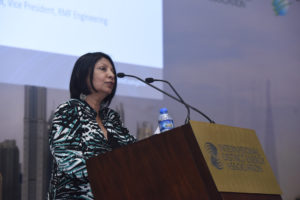
Laxmi Rao, Director of International Programs, IDEA
Laxmi Rao: The folks who do the design don’t often include the experience, insights and horror stories that operational folks could present, to modify and not make the same design [mistakes] over and over again – including over-capacity, not designing for resiliency and some of those factors. My question would be, in your experience, have you found you are at the table at design sessions, or are you left with a design that is cumbersome and difficult?
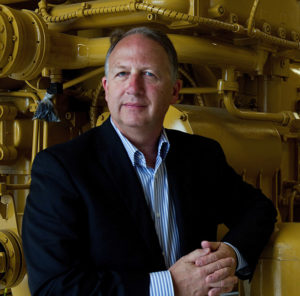
Bruce Ander, CEO of Markham District Energy Inc.
Bruce Ander: We haven’t been around that long, approaching 20 years, but we try to bring our operational group, supply managers in the operations level, into the design process, attending meetings, looking at the design and sitting at the table. In terms of access or maintenance, the space around equipment or the equipment chosen, it certainly includes them – from the buy-in for the plant they accept and have to operate. I mean, when the designers and the engineers are gone, the operations group assume responsibility for the next 20 or 30 years. I think
it makes a difference. It’s hard to measure, but there is something there.

Joan Kowal, Senior Director, Energy & Utilities, Emory University
Joan Kowal: My background was mostly in operations. When I came to Emory and also picked up a design group, it was a perfect nexus, because now you were able to influence design with your operations group. We also had the commisioning group with us, which sits in balance with the design team and operations to ensure operations has a voice at the table. I think it’s important. I think, at first, operators tend to think design engineers know how it should be and would defer to them, and [we] have to invite them to the table, encourage them and ask engineers to let operations group lead in initial stages. I do find once you invite them, they have a great voice in the table, and they participate with commissioning, and you get better transition from design to operations by having that link.
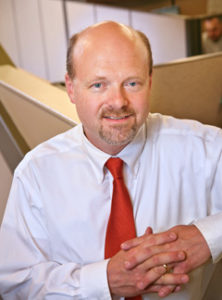
Robert Smith, Vice President, RMF Engineering
Robert Smith: As a designer, we welcome that input from the people that would inherit these plants on simple things like where equipment will go, how you will access it, how you will bring in spare parts – those are rudimentary things, but they’re important. The most successful plants are the ones where the operators have that kind of input and influence to get what they want from what they learned over the years, to get the best outcome.
Rao: Sam, when you provide [equipment], do you find there has been a conversation with many of the [stakeholders] ultimately operating these systems? Who approaches you first?
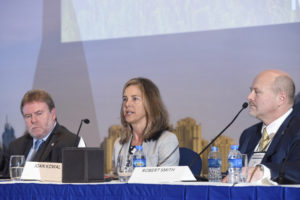
L-R – Sam Chatterton, Joan Kowal and Robert Smith
Sam Chatterton: There are some companies that do this extremely well, involving operators – there is absolutely no substitute. There are companies, where I have to bridge operations. Being able to practically perform that plant and operations is a different reality altogether. We have come a long way in terms of design; I think there is a long way to go in the operational matrix. [Such as for] plants like today in Dubai, when it’s not a design day, [there is] small percentage of company optimisation.
Rao: Yes, I think it’s best practice, not common practice. Ted?
Ted Borer: The operators are not always trained for a standard design drawing for plant. One of the tools we found much more helpful [is a] walk through. Can I walk through it? Can I maintain it? As a design engineer, we need capacity for the design day, for the most extreme day, but that’s not where we live. We generally live on the non-extreme day at some part-capacity load, so a conversation between design engineer and operator is important, so we have turn down to operate in the non-extreme day.
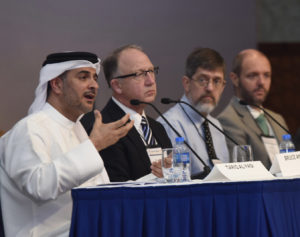
L-R – Tariq Al Yasi, Bruce Ander, Ted Borer and Pablo Izquierdo Lopez
Tariq Al Yassi: It takes, I think, around six months to design a plant – they will operate it for the next 5-10 years. [It’s] important to have the operations team from day one, involved right away from the initial stage and concept design. We created a workshop from one stage to another. The consultant, the technical team and operations team sit in a workshop. Every stage in this workshop might take a week, it might take 10 days. Everything is presented by the consultant and technical team to operators during the small workshop, and if the operators have any requirement, it will be taken by the consultant and design team. Mutually, it really has big value and impact. At the end of the day, when you hand over the plant to the operator after commissioning, they are fully aware of what is going on from past experience with past plants, as it has already been considered and mistakes from previous plants avoided. We don’t need to repeat again. We learn from one plant to another. We don’t like to have two plants that are similar; each plant has to be different from the previous plant, otherwise we are not learning.
Rao: I think we forget the role of experience and insight from those that use this system, and we don’t invite them, because they’re busy, and they can’t take time off, because they are running the system. I find that if you engage with even up to the level of operators, a lot of free wisdom is there, to prevent too many mistakes. My next question is about growing your system and operating multiple systems. Tariq, you have 70 plant rooms? How do you coordinate this network of multiple plants? What tools do you use? Obviously, constraints in number of people, any insights on best practice as you grow these plants from an operators’ perspective?
Al Yasi: The most important thing in the plant is the people. You have the best system in the world, [but if] you don’t have experience, who knows how [it will run]. After having the right people, you have to have the right instruments and equipment… design has to be built having that equipment, [with] software and people who can be acquired properly. Then, I am not going to say it’s easy, [but] it will be an exciting experience operating those plants. We have come up with central demand control, which helps us a lot in operating and controlling multiple plants. As many as 80% of our plants are connected to command and control, and [we are] connecting the rest of the plant this year. The software and equipment helped us a lot in controlling our plants and setting the KPIs we need, to know what we are monitoring. Not all the data are important and essential. Sometimes, we realise we spent a huge amount of time analysing data, which really does not add value to our operations. Now, we are focusing more on the data that is going to help us improve efficiency. [It’s about] understanding our customers’ needs.
Borer: I’ll add to that. We are at four plants, not 74. Thinking of the question you had before, one of the things we have done is to introduce a small business culture into a very large operation. Every client has a plant owner or manager, and it’s Craig’s plan, and they take pride in that. It’s a small business culture in a larger organisation. At the end-of-the-year performance evaluation, it’s the pride introduced at each plant level that counts.
Rao: You mentioned people are important, I think that is universally true in many systems. How do you retain good people and bring new people into the system? I know Ted talks about unique humans watching the data. While data informs us, insights of humans are very important, so to give tribute to those that maintain our system, from performance to bonuses, how do you keep good people working in these difficult jobs? How do you bring in
new people?
Al Yassi: Give a good bonus!
Ander: We attracted good people. We are known in Canada for what we have done, whether CHP or thermal storage, now carbon capture, so when you have a young operator looking to find where they can go, is it a power plant, maybe not as interesting, [but] in terms of being multi-faceted. What we learned in District Cooling, if you have a community skill platform, any number of things, all sorts of things we introduce over the years are very interesting, and it’s a resume builder for operators.
Borer: I agree with you that first, you need to pay people an appropriate wage, but since this conversation is about best practice – it’s about respect. It’s about going to the individual cleaning the chiller tube and saying what did you find? What went wrong? Teach me what your job revealed, that we can take advantage of it in the plant. I think it’s a bit of humility and eye contact with every single person on staff. We have almost no turnover, and people come and continue for their careers, and that’s by choice.
Pablo Lopez: I’m in a different position because of sustainability. In my case, it’s more difficult to attract than to retain. I think integration between design and operation is very good. If someone has handed over something and says, now you have to run the operation profitably, without having that much of a chance of having an input in it, it would be a hard job, and they would not be motivated to do that.
Chatterton: My experience with technical people is that compensation is not what drives them; it’s technical growth, whether in training, technical opportunity or, as Ted said, to be respected. It seems to be a thing, especially in the service industry, that technical recognition. They can easily move to another [company], but the technical growth is key to keeping strong technical people.
Kowal: I think I would add that a lot has to do with pride in the work they do. What we try to do is to make everyone, down to the front line, understand that what they have done has helped us achieve, whether in terms of energy reduction or water reduction. Because, sometimes we settle this goal at a certain level, we talk about it in a meeting, but those in the front line don’t see the results. We try to share the transparency of data with them, for them to know that everything they are doing is imperative for preventive maintenance and helps us achieve our goals, so the pride they contribute to overall goals helps us keep everyone engaged.
Hannah Jo Uy is Assistant Editor at Climate Control Middle East magazine. She may be contacted at hannah@cpi-industry.com
Copyright © 2006-2025 - CPI Industry. All rights reserved.